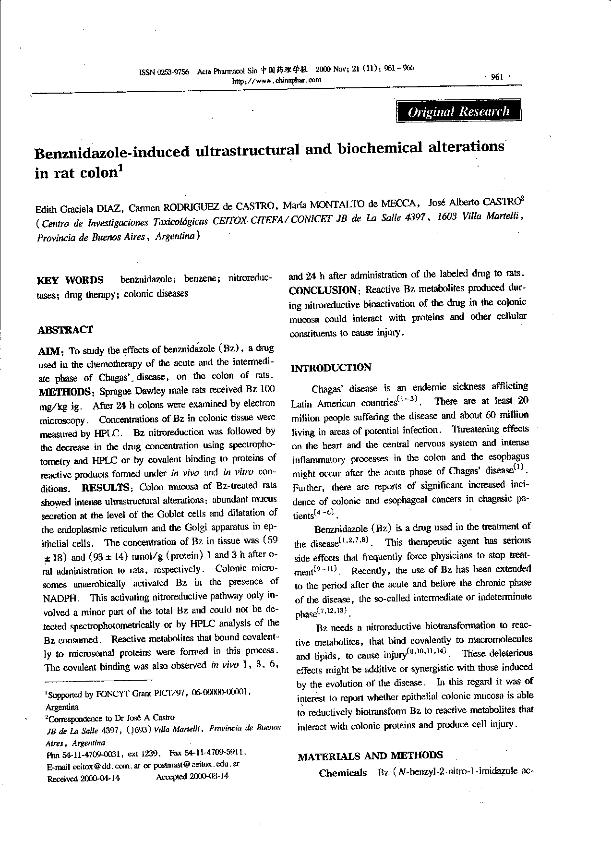Artículo
Benznidazole-induced ultrastructural and biochemical alterations in rat colon
Fecha de publicación:
11/2000
Editorial:
Wiley Blackwell Publishing, Inc
Revista:
Acta Pharmacologica Sinica
ISSN:
0253-9756
Idioma:
Inglés
Tipo de recurso:
Artículo publicado
Clasificación temática:
Resumen
AIM: To study the effects of benznidazole (Bz), a drug used in the chemotherapy of the acute and the intermediate phase of Chagas' disease, on the colon of rats.
METHODS: Sprague Dawley male rats received Bz 100 mg/kg ig. After 24 h colons were examined by electron microscopy. Concentrations of Bz in colonic tissue were measured by HPLC. Bz nitroreduction was followed by the decrease in the drug concentration using spectrophotometry and HPLC or by covalent binding to proteins of reactive products formed under in vivo and in vitro conditions.
RESULTS: Colon mucosa of Bz-treated rats showed intense ultrastructural alterations: abundant mucus secretion at the level of the Goblet cells and dilatation of the endoplasmic reticulum and the Golgi apparatus in epithelial cells. The concentration of Bz in tissue was (59 +/- 18) and (93 +/- 14) nmol/g (protein) 1 and 3 h after oral administration to rats, respectively. Colonic microsomes anaerobically activated Bz in the presence of NADPH. This activating nitroreductive pathway only involved a minor part of the total Bz and could not be detected spectrophotometrically or by HPLC analysis of the Bz consumed. Reactive metabolites that bound covalently to microsomal proteins were formed in this process. The covalent binding was also observed in vivo 1, 3, 6, and 24 h after administration of the labeled drug to rats.
CONCLUSION: Reactive Bz metabolites produced during nitroreductive bioactivation of the drug in the colonic mucosa could interact with proteins and other cellular constituents to cause injury.
Palabras clave:
Benznidazole
,
Benzene
,
Nitroreductases
,
Drug Therapy
,
Colonic Diseases
Archivos asociados
Licencia
Identificadores
Colecciones
Articulos(SEDE CENTRAL)
Articulos de SEDE CENTRAL
Articulos de SEDE CENTRAL
Articulos(UNIDEF)
Articulos de UNIDAD DE INVESTIGACION Y DESARROLLO ESTRATEGICOS PARA LA DEFENSA
Articulos de UNIDAD DE INVESTIGACION Y DESARROLLO ESTRATEGICOS PARA LA DEFENSA
Citación
Diaz, Edith Graciela; Rodriguez de Castro, Carmen; Montalto, Maria; Castro, Jose Alberto; Benznidazole-induced ultrastructural and biochemical alterations in rat colon; Wiley Blackwell Publishing, Inc; Acta Pharmacologica Sinica; 21; 11; 11-2000; 961-966
Compartir




